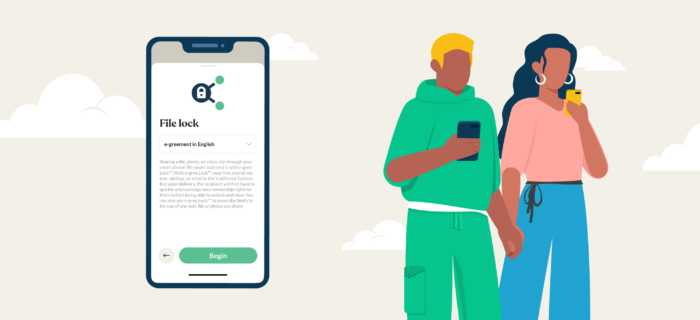2 min read
How to use the Freelance e-greement
As a freelancer, you’ve got a lot on your plate. The last thing you want to think about is the legalities of your business relationships. In a perfect world, you’d just do the work and then get paid. Unfortunately, things aren’t always so easy in our imperfect world.
That’s where e-gree can help. It puts a variety of binding agreements and contracts in the palm of your hand. Whether you’re a writer, editor, photographer, or other type of freelancer, you can quickly and easily create contracts that spell out the terms of your projects so there are no misunderstandings later.
Why do freelancers need contracts?
As a freelancer, you know how important it is to deliver high-quality services, on time and within scope. But as any experienced freelancer will tell you, there will come a time when you and your client may disagree on the terms of the project — and it will probably happen right around the time you’re delivering.
The best way to avoid these kinds of issues is to clearly spell out the scope of the project ahead of time. This includes what you’ll be doing and how, but it should also detail how much you’ll be paid, when you’ll be paid, and by which method. You also should include additional terms that both parties will be bound by, such as who will own the rights to the work and what will happen if work (or payment) is delivered late.
This sounds a lot like a contract, right? And you need lawyers for contracts, right?
With e-gree, you don’t have to spend money hiring an expensive attorney to draw up contracts every time you pick up a new project. Instead, use e-gree’s convenient mobile apps to create your own agreements in just minutes. No matter your industry, e-gree will handle the legal stuff so you can get to work.
How to make a contract with e-gree
Creating a contract with e-gree is extremely simple. All you need is a mobile device (Android or iOS) and a few minutes of your time.
You’ll start out by entering some simple info, such as who you are and who you’ll be working with. From there, you’ll provide details about your project, such as what you’ll be doing, when you’ll have it completed, and how much you’ll be paid.
If you need to spell out additional terms, such as who’ll own the final work or limitations on how the work can be used, you can also provide that information.
When you’re done providing all the pertinent information, e-gree will create a professional, customized contract for your review. Give it a peek (and be in awe of the legal details you may have never thought about), and then give it your stamp of approval by signing with your finger or a stylus.
And that’s it! You’ve just created an e-greement that will protect you when it comes to contract disputes and misunderstandings.
Sharing e-gree contracts
You’ve created a contract, and you’re ready to put it into play. All you have to do is get it into the hands of your client so that they can sign it, giving you the green light to get to work.
Printing? Mailing? Annoying pens that run out of ink halfway through your signature? You can forget about all that with e-gree. Instead, you’ll send your contract digitally — via email, text, messenger, or really any other form of communication you prefer.
Once you’ve sent your contract, all you have to do is sit tight. As soon as your client has signed it, you’ll receive a notification from e-gree so you can proceed with the project.
Working on multiple gigs? Access your e-gree dashboard to see which contracts are active and which are still pending, as well as those that have been rejected. All this info, plus account settings, are accessible from the palm of your hand, so you won’t waste time tracking down emails or printouts.
Tips for making the most of your contracts
Ready to create your own contracts? Before you get started, consider these helpful hints.
Always create a contract
You might be under the impression that only larger projects require a contract, but honestly, you should be creating contracts for every gig you undertake. After all, if a project is worth doing, it’s worth spelling out the details.
How a client reacts to your request for a signed contract prior to starting work can give you a lot of insight into how the relationship may play out. For example, a customer who balks at the idea of putting details in writing and then formally agreeing to them might be someone to stay away from.
On the other hand, you may also encounter clients who’ve never had to sign a contract while working with a freelancer. The fact that you take your work so seriously that you require one may give you an edge.
Sweat the details
A contract that doesn’t cover all the nitty-gritty details might as well not be a contract at all. In order for an agreement to properly protect you, it’s imperative that you spell out as many terms as possible. In addition to the obvious ones, also consider provisions in the event there’s an emergency or the client changes their mind halfway through the project.
Other important details you might cover include what you’ll do if the client requires revisions or extra work, the terms of your cancellation policy, and what happens if the client is late in making payments.
Consider a payment plan
As a freelancer, you’re probably used to getting paid after you’ve completed a project. But there may be instances when you’d prefer different payment terms, such as a portion up-front or monthly payments. This can be especially true when you’re working on large, labor-intensive projects.
And the truth is, there may be times when your clients may also appreciate something other than having to make a lump-sum payment. For some, it might be easier on the pocketbook to make several payments throughout the course of the project rather than one big one at the end.
In these cases, you can easily use e-gree to detail the terms of a payment plan. In addition to spelling out how much you’ll be paid and when, you can also note that you’ll assess late fees or even withhold work if payments are not made on time.















